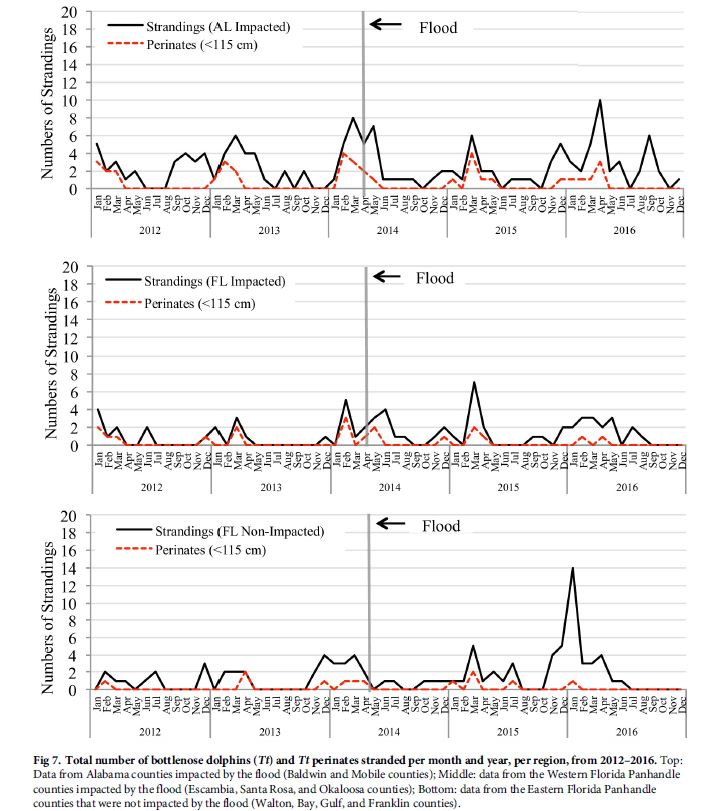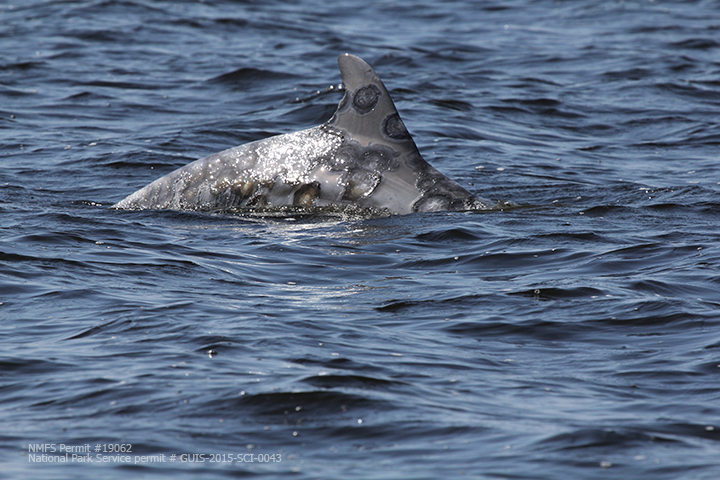What Happens When Dolphins and Freshwater Mix?
Prolonged exposure to freshwater is linked to adverse health conditions, immune deficiencies, and even dolphin deaths, but there’s still a lot we don’t understand.
SDRP Post-doctoral Scientist Dr. Christina Toms was conducting photo identification surveys in Pensacola Bay, Florida, as part of an ongoing study to provide the first comprehensive assessment of population dynamics for bottlenose dolphins in that system in 2014 when the city experienced historic rainfall.
According to some estimates, 24 inches of rain fell over the area in just 24 hours — an extreme influx of freshwater into Pensacola Bay. This natural disaster led to a “natural” experiment: Would the surge of freshwater into the Bay — and the dolphins’ subsequent prolonged exposure to it — lead to an increase in skin lesions?
Surprisingly — and contrary to expectations — a widespread outbreak of skin lesions did not seem to materialize despite the fact that salinities in the Bay remained low for months. Instead, only a handful of individuals exhibited extensive skin lesions that in some cases persisted or worsened over time.
Toms and her coauthors discuss the implications in “Skin lesion and mortality rate estimates for common bottlenose dolphin (Tursiops truncatus) in the Florida Panhandle following a historic flood” recently published in the journal PLOS One. The study shows that the factors that determine whether flooding and freshwater exposure will lead to serious health concerns — or result in mild responses — are still poorly understood.
Some of the new questions that have emerged following the study:
- Was freshwater not the primary cause of skin lesions?
- Did some of the individuals have compromised immune systems before the freshwater exposure that left them more vulnerable to viruses or other infectious pathogens that washed into the system during the flood?
- Were dolphins able to mitigate risks from freshwater exposure by the way that they utilized the habitat?
The study also raises additional questions about how coastal dolphin populations should be managed in locations where they may be at a higher risk of freshwater intrusion — especially intrusion from human-related causes.

“This study has led to a much larger discussion about dolphin skin issues in the Gulf of Mexico and their potential causes,” Toms said. “There are other systems — like Galveston and Mobile Bays — that have also experienced extensive skin issues surrounding flood events and we’re now working collaboratively with colleagues such as former SDRP graduate student Kristi Fazioli to better characterize and measure the problem with the aim of gaining a better understanding of the causes of these skin issues and potential threats to dolphin health.”
- Coauthors: Tori Stone and Traci Och from the Department of Biology, University of West Florida, Pensacola, Florida
- Read the full study: https://doi.org/10.1371/journal.pone.0257526
- Citation: Toms, C.N., Stone, T., Och, T. Skin lesion and mortality rate estimates for common bottlenose dolphin (Tursiops truncatus) in the Florida Panhandle following a historic flood. PLOS ONE 16(10): e0257526. (2021)
Support for this research was provided through the University of West Florida undergraduate research awards, the Arnold Haverlee Exploration Endowed Scholarship, the University of Central Florida (UCF), and the UCF Research Foundation.





